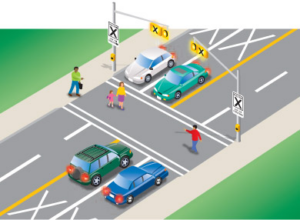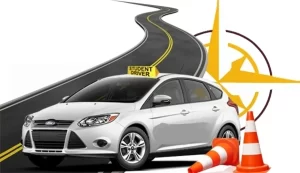Have you ever wondered why that speed limit sign shows the number it does? Is it just a random suggestion, or does it play a vital part in keeping our roads safe? Speeding is a cause in many deadly crashes each year in Canada. For anyone learning to drive, taking driving lessons, or even experienced drivers in a driving safety course, knowing why speed limits matter is key. This complete guide looks at the importance of role of speed limit in road safety. We’ll explore how they are set, the different kinds you’ll see, and the serious results of ignoring them. By the end of this post, you’ll better understand why following speed limits is a basic part of safe driving and how good driver training schools teach this important idea.
What Exactly Are Speed Limits?
Simply put, a speed limit is the highest legal speed that cars can travel on a certain part of road. Sometimes, minimum speed limits are also posted, mostly on highways, to keep traffic flowing well and stop dangers from very slow driving. These limits aren’t just guesses; traffic experts set them based on careful study and road design.
Think of speed limits as important ways to communicate. They tell drivers the speed that’s seen as reasonably safe for that specific road when things are normal. Things like how the road is designed (curves, width, visibility), how much traffic there is, if there are intersections or walkers, and past crash data all help decide the right limit. Ignoring them isn’t just breaking a rule; it’s ignoring important safety information.
Why Are Speed Limits Crucial for Road Safety?
The link between speed and safety is based on physics and how quickly people react. First, going faster greatly increases how far you need to stop. According to the National Highway Traffic Safety Administration (NHTSA) in Canada, the faster you go, the more distance your car covers before you can react to danger, and the more distance it takes to brake fully. This longer stopping distance makes the risk of a crash much higher.
Second, speed greatly changes how bad a crash is. The energy of a moving car increases a lot with speed – if you double the speed, the energy that’s released in a crash quadruples. This means crashes at higher speeds are much more likely to cause serious injuries or deaths. Speed limits help control this energy, lowering the possible impact and protecting drivers, passengers, walkers, and cyclists. Good driving schools in North York teach that following limits is vital.
Also, good speed limits help traffic move more smoothly. When cars travel at very different speeds, it makes conflicts, lane changes, and rear-end crashes more likely. Consistent speeds, guided by limits, help create a safer environment for everyone using the road. This is especially important in busy areas often practiced during a driving skills test.
How Are Speed Limits Determined in Canada?
Setting speed limits isn’t easy; traffic engineers and transportation groups use set methods. While exact practices can vary a bit by state or province, common ways include engineering speed studies and looking at the 85th percentile speed. An engineering study looks at road features (shape, how far you can see, what’s on the side of the road), how much and what kind of traffic there is, and past crash history.
The 85th percentile speed is the speed at or below which 85% of drivers travel on a given road when traffic is flowing freely. This is often a starting point, assuming most drivers choose a speed they think is reasonable and safe. However, this is balanced with other things like how many walkers are around (especially near schools or parks), possible dangers, and what the road is meant for (e.g., a neighborhood street vs. a major highway). Default limits (set by law for certain road types if no sign is posted) also play a role.
In the end, the goal is to set a limit that’s safe, makes sense, and is easy to follow, based on the road’s specific situation. Knowing this process helps drivers understand that limits are set for real safety reasons, not just to give tickets – a concept taught in good driving classes.
What Are the Different Types of Speed Limits?
Drivers see different kinds of speed limits:
- Posted Speed Limits
These are the common black-and-white signs showing the highest legal speed. They are the most common type and apply unless specific conditions mean a lower speed is needed.
- Statutory Speed Limits
These are default limits set by law (state/province) for certain types of roads (e.g., 25 mph in neighborhoods, 55 mph on rural highways) when no specific limit is posted. Drivers should know these.
- Advisory Speed Limits
Often on yellow warning signs (e.g., before curves, exit ramps), these suggest a safe speed for that specific situation but aren’t usually legally enforced as a strict limit, though going much faster could lead to a reckless driving charge if a crash happens.
- Variable Speed Limits
More and more used on major highways, these limits can change based on real-time conditions like traffic, weather, or road work. Electronic signs show the current legal limit.
- School/Construction Zone Limits
These are much lower speed limits that apply at certain times or when workers/children are present. They have serious penalties for violations because people in these areas are more at risk. Getting ready for situations like these is part of good driver education, not just passing the permit test.
What Happens When Speed Limits Are Ignored?
Ignoring speed limits has big dangers and results beyond just the immediate risk. First, the chance of being in a crash goes up a lot. Speeding makes reaction time slower, increases stopping distance, and makes it harder to control the car, especially in emergencies or bad weather. This is a main focus in any driver improvement course.
Legally
speeding can lead to large fines, points on your driving record, and possibly losing your license, especially for repeated or very high-speed offenses. These penalties exist across the Canada. Also, traffic tickets like speeding almost always mean higher car insurance costs, adding a significant financial burden. The cost of a driving test is small compared to the long-term costs of speeding tickets.
Beyond personal results
speeding uses more gas and creates more pollution, hurting both your wallet and the environment. Most sadly, it leads to preventable injuries and deaths, causing great pain and loss for families and communities. Respecting speed limits is a basic part of being a responsible driver.
How Can Understanding Speed Limits Make You a Confident Driver?
Real driving confidence isn’t about speed; it’s about control and knowing the road. Learning why speed limits exist changes them from just rules to important safety information. Knowing that a lower limit often means curves, hidden roads, many walkers, or other dangers makes you more aware of your surroundings.
This knowledge, often taught by good driving instructors, helps you see ahead instead of just reacting. Driving at the right speed improves your ability to steer smoothly, brake well, and keep a safe distance from other cars. It’s a core part of defensive driving – making choices that lower risk for yourself and others. Learning to manage speed well is needed to pass the driving test and become a truly safe and sure driver for life. Many new drivers use practice tests for their permit (like a g1 practice test in Ontario), but practicing driving skills is key.
Conclusion
Speed limits are much more than just numbers on a sign; they are carefully decided, science-backed safety systems that are vital for reducing crashes and saving lives on roads across the Canada. They consider how the road is designed, traffic conditions, how quickly people react, and the physics of moving cars. Knowing the purpose behind different kinds of speed limits, how they are set, and the serious results of ignoring them is key for every driver.
Following speed limits isn’t about losing freedom; it’s about being responsible and helping create a safer place for everyone. It lowers crash risk, makes crashes less severe, helps traffic flow better, and protects those who are most at risk on the road. Learning to manage speed well and knowing why limits matter are basic skills. At Premium Choice Driving School, we teach a full driver education that’s more than just passing a test; we help you become a smart, responsible, and confident driver ready for a lifetime of safe driving.





